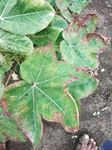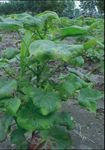NATURAL INSECT PEST CONTROL
←
→
Page content transcription
If your browser does not render page correctly, please read the page content below
NATURAL INSECT PEST CONTROL
Some of the most common insect pests in Tanzania, particularly found on
cotton, maize, sugarcane, pumpkin, okra and bean plants are:
APHIDS MEALYBUGS LEAFHOPPERS
Aphidoidea Pseudococcidae Cicadellidae
©Jim Baker ©SaferBrand
©SaferBrand
Natural pest control is essential to ensure that both quantity and quality of crop
production is at its highest potential. It is more beneficial than chemical pest
control, which often contaminates and damages non-target species (including
humans), soil/water quality and the surrounding environment.
The use of agroforestry landscapes is beneficial
to both crop and farmer. Integrating trees and
other plants with crops is advantageous
because:
• Increase natural enemies to control pests
• increase pollinators to increase crop
yield
• increase microorganism abundance in
soil to increase soil productivity
• Promotes balanced ecosystem
©resilience
The use of local natural enemies and botanical plants (natural pesticides) is
important as they are generally affordable, effective and efficient methods of
pest control.
AGRISYS Tanzania is a project led by Dr Marion
Pfeifer (agrisystanzania@gmail.com) alongside a
large team, to research biological and human
well-being benefits that can be provided by
agroforestry in tropical landscapes. They work to:
1. Identify the key benefits of agroforestry
2. Identify the agronomic potential of
agroforestry landscapes
3. Validate sustainable intensification
practices in the area, including biological
and human well-being factors
4. Adapt agronomic practices &
management, taking into account land
potential and the social & governance
frameworkCOTTON APHID (Aphis gossypii)
The cotton aphid is one of the most common, adaptable and widely spread pests. It feeds
on the sap of young plants, deposits honeydew, can transmit viruses and, in high
populations, can kill the crop.
- range from yellow to very dark (almost
black) green
- Yellow in hot, dry summers & pale-dark
green in cooler seasons
- Very small aphid- adults range from below
1-1.5mm in length and 0.34mm in width
- Most adults are wingless
©Timothy A. Elbert- Aphis gossypii adult and nymph
The pest is mainly found on crops such as cotton, SYMPTOMS on crop:
pumpkin and tomatoes, but can also be found on
okra, beans, sugarcane, maize, among many 1. yellowing of leaves
others. 2. puckering/curling of leaves
3. plants become covered with
black sooty mould
4. plants become stunted &
stems twisted
5. sometimes, virus cotton blue
disease
6. sometimes, presence of ants
can be associated with
cotton aphid
©CABI- Left: black sooty mould found after pest have populated & Right: wilting of leaves
Natural enemies can be used to reduce the numbers of cotton aphids in the crop and
reduce loss of crop yield, by predation. The Chrysoperla carnea (green lacewing) has
shown to be very effective in controlling the aphid population in cotton.
The adult green lacewings are pale green in
colour and around 12-20mm in length. The
adults only feed on nectar, pollen and aphid
honeydew but their larvae are the active
predators of the cotton aphid. In order to
survive, the lacewings require:
- A source of moisture, so larvae do not
desiccate
- Planting of flowering plants, so adults
©AJC1
can feed on pollen & nectar like
- Low level of aphids already, so adults
can feed on honeydew deposits
Lacewings particularly like Asteracae flowers
(sunflower, cosmos, dandelion) or Apiaceae
flowers (dill, fennel, angelica) so planting
along the margins of the field or in nearby
©Donald Hobern
fields would be helpful for pest control.
Above: adult green lacewing; Below: green lacewing larvaeYELLOW SUGARCANE APHID
(Sipha flava)
The yellow sugarcane aphids are widespread in warmer climates, feed on the lower
side of crop leaves, inject toxins in them and produce honeydew.
©UCIPM ©Seelavern Ganeshan
Rice grain ~5mm - Commonly lemon yellow but
sometimes pale green in colour
- Small pests- around 2mm long
- Covered in small spines
- Two double rows of dark spots
on back
- Both winged and wingless
forms
The yellow sugarcane aphid is most found as a pest on crops like sugarcane, millet,
maize, rice and sorghum.
©Gregg S. Nuessly
Symptoms of infestation include:
- Abnormal colouration of leaves
(purple)
- Yellowed/red or dead leaves
- Can reduce growth
- Sooty mould fungus on honeydew
- Severe damage, plant lodging or
stalk rot
- Damage on underside of leaves
©Greg Cronholm
To reduce numbers of yellow sugarcane aphids
and loss of crop, some ladybird species in Tanzania
such as Cheilomenes lunata, Epilachna
fulvosignata and species of Scymnus, among
many others, should be protected, as they are
natural enemies. Both adult and nymph forms are
©JMK
predators and in order for them to survive and aid
pest control, they require:
Cheilomenes lunata
- Moisture for survival of larvae
- Shelter from harsh climate
- Source of pollen, so flowering plants required
Similarly, to the green lacewing, most species of
ladybird are attracted to Asteracae flowers
(sunflower, cosmos, dandelion) or Apiaceae
flowers (dill, fennel, angelica). Making sure plants
like these are present will help keep the local
natural enemies control the pests.
©Pixabay
Sunflower sINDIAN COTTON JASSID (Amrasca bigutulla)
The Indian cotton jassid is also known as the Indian cotton leafhopper, green
jassid, cotton leafhopper or okra leafhopper. It attacks the crop all year round by
sucking its sap and laying eggs within the soft plant tissue.
• small (adults ~0.6-3mm
©Agrinfobank
long)
• winged species (both
jump & fly)
• yellowish green in colour
with black spots
• shiny & almost transparent
©H.M. Tahir
The cotton jassid feed on the underside of crops like beans, sorghum, maize,
cotton and okra, among others.
SYMPTOMS of infestation:
©Plantix
©TNAU Agritech Portal
- discoloration of leaves
- curling of leaves sometimes resulting
in dropping off
- outer zones turn yellow-red-white
- can retard plant growth & reduce
yield
- sooty mould can grow from
secreted honeydew
To reduce green jassid populations, natural
enemies like the species of ladybird, ants and
spiders, should be encouraged to remain in the
environment. To support these species to feed
©Paul Bertner
on the jassids:
Jumping spider (Saltcidae) • flowering plants like sunflowers or
angelica should be planted nearby
(either along the margins of the field
crop or in neighbouring fields)
• sources of water/moisture must be
present (to support eggs, nymphs &
adults)
• established crop pests (honeydew is a
source of food for some)
Biological pesticides that come from plants like
the neem tree, have also proved useful as a
form of pest control, to increase crop yields.
©Johnny’sSelectedSeeds
Angelica flowering plantNEEM PLANT (Azadirachta indica)
The neem plant is very • Can grow up to 30m tall
resilient, inexpensive, can with deep roots
grow in almost anywhere • Flowers which attracts
and is usually grown from pollinators
the seed (but can do from • Ripe fruit are yellow-green
cuttings or root suckers). and have a seed which
Most of the parts of the contains kernels
tree can be used, for • Can live up to more than
medicinal, cosmetic and two centuries
natural insecticide • Thrives under hottest
purposes. The products of conditions
the neem tree also • Grows well on dry, infertile
generally have a low sites, above sea level
toxicity to non-target • Require sunlight and regular
organisms. moisture
©Fashionforall
The neem tree is important as it is very useful in the form of a
biopesticide, to control crop pests, by:
- Repelling insects from crop
- Preventing feeding on the crop
©cgtrader - Disrupting insect growth, metamorphosis and
reproduction
Mature neem fruit (1)
How to extract the biopesticide
compounds from the neem plant:
1. Collect the matured fruit and
remove seeds
2. Clean the seeds and dry them out
(spread out in sun)
3. Pound the seeds to remove the shell
©indiamart
and get the kernels
4. Crush the kernels by pounding (using
©Hayavadhan
Neem dried seeds (2)
pestle and mortar)
5. Sieve through the pounded pulp to Crushed kernel powder (5)
get greenish brown powder
6. Stream the powder by placing over
©Bhagwati
boiling water for 15-20 minutes
7. Press the product to extract the oil
8. Dilute 0.25ml of the neem oil with
20litres of water as an aerial spray
9. Spray over the crop leaves
©HiloGrowShop Neem oil (7)
The neem spray will be particularly beneficial to insect pests such as the cotton
jassid, the cotton aphid and the yellow sugarcane aphid, among many others, to
reduce their populations and increase crop yield.You can also read



























































